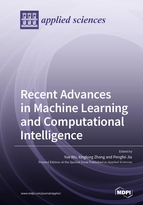Recent Advances in Machine Learning and Computational Intelligence
A special issue of Applied Sciences (ISSN 2076-3417). This special issue belongs to the section "Computing and Artificial Intelligence".
Deadline for manuscript submissions: closed (10 January 2023) | Viewed by 31405
Special Issue Editors
Interests: computer vision; image processing and pattern recognition; theory and applications of computational intelligence
Special Issues, Collections and Topics in MDPI journals
Interests: reinforcement learning; intelligent control; autonomous robots; motion planning
Interests: electronic nose; pattern recognition; intelligence sensor
Special Issues, Collections and Topics in MDPI journals
Special Issue Information
Dear Colleagues,
Machine learning and computational intelligence have been applied to various areas and witnessed many successes. Researchers explore many intelligent algorithms which are characterized by computational adaptability, robustness, and high performance. These algorithms facilitate intelligent behavior in complex and dynamic environments and the development of technology that enables machines to think, behave, or act more humanely.
This Special Issue aims to present and discuss the most recent innovations, trends, concerns, challenges, solutions, and application fields in machine learning and computational intelligence. The topic of interest include but are not limited to:
- Artificial Intelligence in general, and deep learning, machine learning, data mining;
- Reinforcement learning and applications;
- Intelligent control, neuro-control, and their applications;
- Decision making, planning, and control for autonomous robots;
- Intelligence sensors, evolutionary computation, fuzzy logic, etc.
Dr. Yue Wu
Dr. Xinglong Zhang
Dr. Pengfei Jia
Guest Editors
Manuscript Submission Information
Manuscripts should be submitted online at www.mdpi.com by registering and logging in to this website. Once you are registered, click here to go to the submission form. Manuscripts can be submitted until the deadline. All submissions that pass pre-check are peer-reviewed. Accepted papers will be published continuously in the journal (as soon as accepted) and will be listed together on the special issue website. Research articles, review articles as well as short communications are invited. For planned papers, a title and short abstract (about 100 words) can be sent to the Editorial Office for announcement on this website.
Submitted manuscripts should not have been published previously, nor be under consideration for publication elsewhere (except conference proceedings papers). All manuscripts are thoroughly refereed through a single-blind peer-review process. A guide for authors and other relevant information for submission of manuscripts is available on the Instructions for Authors page. Applied Sciences is an international peer-reviewed open access semimonthly journal published by MDPI.
Please visit the Instructions for Authors page before submitting a manuscript. The Article Processing Charge (APC) for publication in this open access journal is 2400 CHF (Swiss Francs). Submitted papers should be well formatted and use good English. Authors may use MDPI's English editing service prior to publication or during author revisions.
Keywords
- artificial intelligence
- deep learning
- machine learning
- data mining
- reinforcement learning
- intelligent control
- intelligence sensor
- autonomous robots
- evolutionary computation
- fuzzy logic








